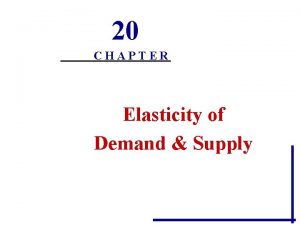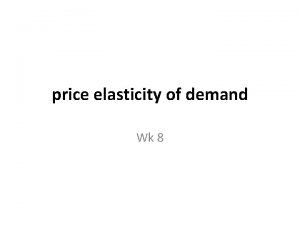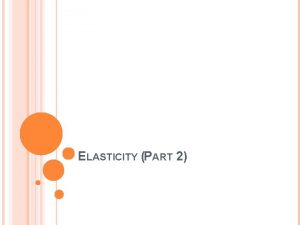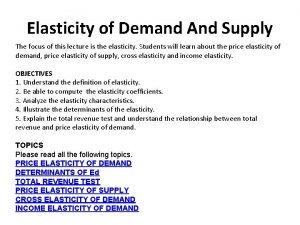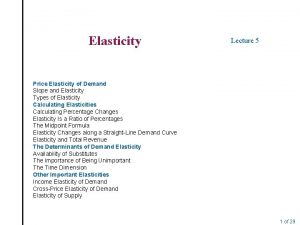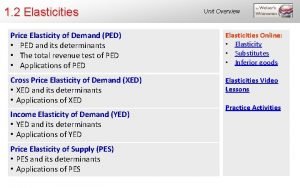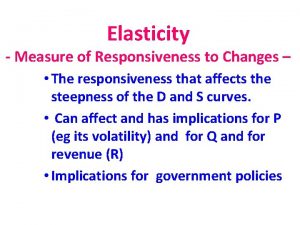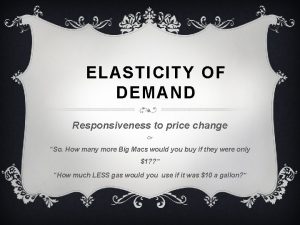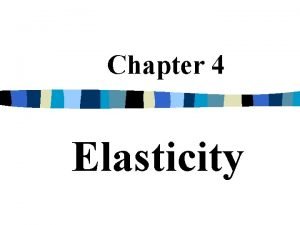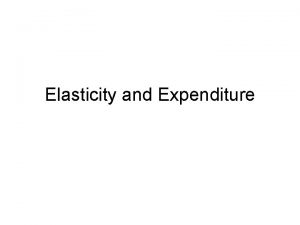Elasticity Measures responsiveness to change in price Measures
















- Slides: 16

Elasticity Measures “responsiveness” to change in price (Measures a Movement; Price Effect)

Price Elasticity of Demand w Sensitivity of quantity demanded to price changes w Elastic: Small P-change, large Q-demanded change w Inelastic: Large P-change, small Q-demanded change

Elastic, Inelastic w Elastic – E(d) > 1 w Inelastic – E(d) < 1 w Perfect Inelastic – completely price Insensitive – E(d) = 0 w Perfect Elastic – Completely Price Sensitive – E(d) = infinite

Coefficient of Price Elasticity w To determine how elastic a product is, in other words, how demand for that product will be affected by a change in price, use the following equation. w E(d) = ( QD/QD) / ( P/P) w Allows us to compare across markets and other goods

Practice w Starting at Price P 1 = 20, Quantity Q 1 = 200 w Price goes to P 2 = 24, Quantity Q 2 = 180 n n P 1 = 20 P 2 = 24 Q 1 = 200 Q 2 =180 [(180 -200)/200] / [(24 -20)/20] (20/200) / (4/20) =. 1/. 2 E(d) =. 5

Elasticity and Demand Curves w Example: 10% Price Increase w D Inelastic [E(d) < 1] n QD decrease less than P increase w D Elastic [E(d) > 1] n QD decreases more than price increase P 1 = 40 P 2 = 44 QD for each curve?

Practice w Determine the Elasticity. w P 1 = 2 w P 2 = 4

Practice w Determine the Elasticity. w P 1 = 100 w P 2 = 200

Example w Reaction to raise in price of cigarettes by Teenagers and Adults. Teenagers Adults Why is there a greater reaction from the teenagers?

Perfectly/Inelastic Demand w Perfectly Inelastic: QD is unresponsive tp P change n n Draw a demand curve that displays Perfect Inelasticity. Examples w Perfectly Elastic: QD totally responsive to P change n n Draw a demand curve that displays Perfect Elasticity. P-increase: QD = 0 P-decrease: buyers buy all they want Examples

The Elasticity of a good’s demand tends to increase with: w Number of closes substitutes. If there are 10 brands of bicycles available and the prices for one of them increase, the quantity of that brand demanded is likely to fall a lot.

Elasticity (Cont. ) w The proportion of income spent on the good. Consider gum and cruise price-change scenarios. The quantity of cruises purchased will probably be more affected by a 50% price increase than the quantity of bubble gum because an extra 2 cents is not a big deal but an extra $500 is more likely to be prohibitive.

Elasticity (Cont. ) w Time w When time is short, it is more difficult to change purchasing patterns in response to changes. The more time consumers have to adapt, the more they are able to find substitutes or learn to do without goods whose prices have increased.

Elasticity (Cont. ) w The lack of importance of a good w The less essential a good is, the more likely consumers are to forego the good when it becomes more expensive.

Luxuries v. Necessities w Goods with an elastic demand are categorized as luxuries. w Goods with an inelastic demand are categorized as necessities.

Why should a business care about the elasticity of demand? w One reason is that the elasticity determines what happens to revenue when price changes. w Revenue = Price x Quantity w When facing a inelastic demand, to bring in more revenue while selling fewer units, raise the price of the good.
 Price elasticity of supply measures how responsive
Price elasticity of supply measures how responsive Kilala ito sa katawagang maximum price policy
Kilala ito sa katawagang maximum price policy Price and income elasticity
Price and income elasticity Yed formula
Yed formula Price elasticity of supply
Price elasticity of supply Katherine advertises to sell cookies
Katherine advertises to sell cookies What are the 5 determinants of price elasticity of demand
What are the 5 determinants of price elasticity of demand Numericals on elasticity of demand
Numericals on elasticity of demand Demand analysis example
Demand analysis example Perfectly elastic demand curve is
Perfectly elastic demand curve is Price elasticity of demand formula examples
Price elasticity of demand formula examples What are the 5 determinants of price elasticity of demand
What are the 5 determinants of price elasticity of demand Slutsky equation
Slutsky equation Elasticity of supply
Elasticity of supply Total outlay method formula
Total outlay method formula Xed economics formula
Xed economics formula Own price elasticity
Own price elasticity
